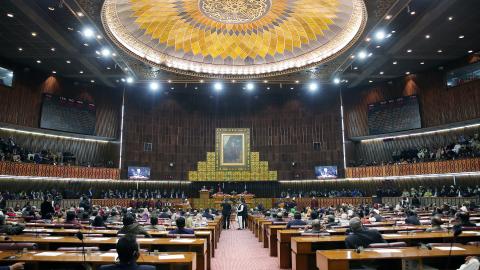The idea behind this effort is to identify key events and decisions, which could have altered the course of history had they gone differently. In Pakistan’s case, there is a long list of turning points where a different choice or decision by those in power could have altered the country’s course. One that is given little attention is: ‘What if there had been no political engineering by institutions of state and the country’s politics had taken its natural course after independence in 1947?’
The first attempt at political engineering was undoubtedly the dismissal of prime minister Nazimuddin’s government by the then governor general in April 1953 and the dissolution of the Constituent Assembly in October 1954 just as it had finalized the draft of Pakistan’s first constitution. If these two steps had not been undertaken, and endorsed by the Supreme Court, Pakistan would have adopted the 1954 constitution and held general elections.
Judging by the results of the 1954 provincial elections in erstwhile East Pakistan, the Awami League would have emerged as the single largest party in undivided Pakistan and its leader, Huseyn Shaheed Suhrawardy, would have become prime minister. Suhrawardy had already demonstrated his ability to work with smaller parties by letting A K M Fazlul Haq, of the relatively small Krishak Sramik Party (KSP), become chief minister of East Bengal even when Suhrawardy’s Awami League held the largest number of seats in the provincial assembly.
Suhrawardy would have found small party partners in West Pakistan and formed an effective government. The Awami League had a significant presence in West Pakistan at the time and the Muslim League, though defeated in the eastern wing, still retained pockets of support there, while being the largest party in Punjab. The Muslim League could have joined the Awami League in a government of national unity or it could have chosen to sit in opposition. Either way, a parliamentary system would have started functioning, under a federal constitution and two major national parties.
Both the Awami League and the Muslim League of the early 1950s were broad-based political parties, with leaders drawn from all classes of society. The Muslim League had more landowners in its top ranks because of its strength in Punjab and Sindh, but its public faces included lawyers and urban professionals. The Awami League’s leaders were largely non-feudal, but the party still had landowners among its ranks.
In addition to these two parties, the National Awami Party (NAP) represented the country’s left while the Jamaat-e-Islami and Nizam-e-Islam Party served as the voice for the Islamists. All parties had national, provincial, and district level organizations and their top leaders were duly elected at regularly held party conventions. Pakistan had the elements in place for a parliamentary democracy and could have moved forward like its larger neighbour and twin, India.
But governor-general Ghulam Muhammad’s attempt at political engineering, fully backed by the army chief, General Ayub Khan, and the judiciary, derailed the process. Still, the country’s politics had not yet completely fragmented. That process began with the abrogation of the 1956 constitution in 1958, coupled with imposition of martial law. Since then, Pakistan has witnessed a series of attempts at political engineering that continue to hold back the country’s political evolution.
‘What if’ General, later Field Marshal, Ayub Khan had not intervened? Had elections scheduled for early 1959 gone ahead, the country would have still witnessed a contest between Awami League and Muslim League as the two major parties. The 1954 intervention and subsequent events had resulted in the creation of a pro-establishment Republican Party, which would have also ended up with some representation in parliament. The left-wing NAP and the Islamists would have had their voices heard as well, proportionate to the number of elected representatives.
If Muslim League had won the hypothetical 1959 election, Khan Abdul Qayyum Khan would most likely have been prime minister, but the party had several other leading figures, too, to claim the job. Suhrawardy was the Awami League’s clear choice for the top job. Both had experience of the independence struggle, both were established politicians, and both understood administration. The opposition would have had similarly mature figures in its ranks. Compare them to the post-political engineering products, and the gradual decline in the quality of political leadership in the country becomes all the more apparent.
Ayub Khan justified his intervention as a once-in-a-lifetime effort at course correction. Every would-be political engineer since then has also thought the same thing: a little engineering here, a little pressure there, barring X, promoting Y, and the country will finally be on its way to stability and prosperity. But the simplistic notions that ‘Good, honest leadership is all the country needs’ and ‘All we need to do is to breed better politicians’ did not resolve Pakistan’s problems under Ayub Khan or in the years after him.
In his autobiography ‘Friends Not Masters’, Ayub Khan raised questions about the ineffectiveness of parliamentary democracy and the lack of education of the populace that have been raised after every few years, after each new non-political intervention. But, 65 years after the first attempt at political engineering, the country is far from attaining universal literacy or implementing land reform to curtail the influence of landlords. The questions facing the country remain the same and the answers have not been found.
Had political engineering been the answer to these questions, multiple engineering attempts would have, by now, produced a very different political landscape.



















